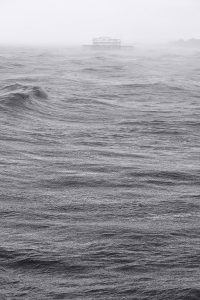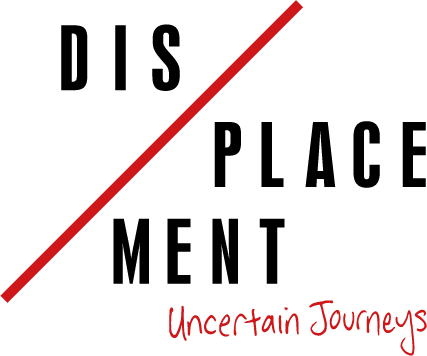Conference venues are challenging spaces for artistic installations. Conference delegates need to retain their focus on the official programme and benefit from networking opportunities. DISPLACEMENT’s activities during formal conferences or meetings complement PDD’s work through a process of engagement that takes advantage of pauses between the formal programme and the physical spaces outside official meeting rooms.
At large international, intergovernmental conferences, such as when PDD hosts a side-event, DISPLACEMENT proposes a visual and sound looping slideshow of artistic works that could be viewed as participants wait for the session to begin. Other possible artistic interventions include a “pop-up” art display, projections in the hallways between meeting rooms, and temporary floor tiles with images that can be walked on by participants. Depending on the venue, images could also be projected on the outside of conference buildings. Brochures, available in print or online as PDFs, would be available to accompany the artistic interventions.
For PDD-organized regional meetings, training events or other conferences, DISPLACEMENT proposes stand-alone exhibitions featuring local artists from the region, complemented by explanatory brochures included in the participants’ meeting materials. Images of commissioned artwork addressing disaster displacement-related themes could also be printed and displayed on participants’ luncheon tables. Additional region-specific interventions at PDD events could be developed based on collaboration with local artists and cultural institutions.
All the displays and materials mentioned above could also be made available to PDD partners for use at similar events they host where PDD is not present.
Cultural dialogues
Many artists, critical commentators, cultural organizations and art educational institutions share a common concern about displacement, disasters and climate change, but may not be aware of or linked to intergovernmental efforts to address these challenges.
DISPLACEMENT proposes a series of events and workshops with local and invited artists, students, academics and organisations alongside official PDD events in different regions of the world. Cultural dialogues will be planned in partnership with regional cultural or academic institutions to identify relevant local and regional artists. The dialogues will seek to i) stimulate discussion amongst cultural actors about disaster displacement, ii) encourage the production of new artwork, and iii) leave behind a legacy of enhanced engagement and collaboration between cultural actors. The cultural dialogues will also explore opportunities for discussion and exchange between artists and policymakers.
In 2019, DISPLACEMENT proposes a global meeting to bring together a select group of regionally representative artists who are particularly committed to addressing disaster-displacement issues in their work. The global meeting will aim to: i) consolidate regional examples of artistic practice and research on disaster displacement and climate change-related themes, ii) create a cultural network on disaster displacement for future collaboration, and iii) contribute to PDD’s efforts to address knowledge and data gaps. Members of the PDD Advisory Committee from other technical areas will also be invited to develop collaborative research projects with members of the cultural network on disaster displacement.
Online Gallery, Exhibition and Publication
DISPLACEMENT’s online platform makes the project accessible to the general public. The website features an online gallery displaying selected artwork addressing disaster displacement (video, stills and sound). It also includes background information about disaster displacement and PDD, and promotes DISPLACEMENT-related projects, upcoming events and calls for contributions through social media.
In 2020, DISPLACEMENT proposes a large-scale, touring exhibition to bring greater visibility to the work of selected artists that address disaster-displacement and climate change-related themes. The exhibition will profile both existing and newly-commissioned work to ensure regional diversity and representation.
A series of short, region-specific publications will accompany the exhibition, and include high quality visual representations of artistic works, supported by commissioned commentary and essays from art critics and technical experts on disaster displacement and climate change. The publications will be bilingual depending on the regions they represent, in English, French and Spanish.

